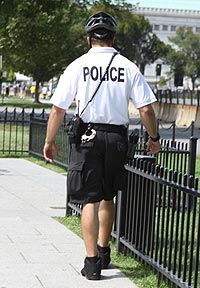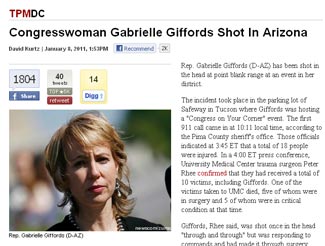Yesterday, Saturday, January 8th, 2011, a gunman shot – at point-blank range – U.S. Representative Gabrielle Giffords (D, AZ) as she was at a meet-and-greet in her home district.
The assassination attempt left six dead, including a federal judge and a nine-year-old girl, and over a dozen injured, many critically.
Giffords is currently out of surgery, and doing well (considering the circumstances). Long-term prognosis has not even been mentioned.
A couple of quick notes:
- There can be no excuses – just explanations – for this carnage.
- I’m appalled by all this senseless slaughter. A representative, doing what reps do on weekends – making themselves available to constituents and the press – was, apparently, targeted for a cold-blooded assassination. Have we come to this?
- This was a relatively unknown member of the House of Representatives. Yes, a Democrat in a red state, but not some politico who gets attention (pro/con) like, say, former half-term Governor Palin, President Obama, Senator John McCain and so on. Why her? That’s one of the scary aspects of this. Obama – as the first African-American president – will, sadly, get a bunch of death threats. But Giffords? Or any other below-the-radar government official/aide. Why?
Lots of talk on the intertubes about this, obviously.
There is no upside to this for anyone, yet there is a lot of finger-pointing.
Taking a longer view of the situation, HuffingtonPost.com’s Howard Fineman puts his finger on the bigger picture – while not ignoring the incredible suffering this shooter has inflicted on individuals, the community and the nation as a whole.
The shooting of Rep. Gabrielle Giffords is a watershed event in many ways, some of which we cannot yet know, but one of the clearest and simplest is this: Congress and its members are about to be permanently quarantined, physically isolated, from the people it and they represent.
Thirty years ago, there was no such thing as security on Capitol Hill or for members. Members of the public were free to roam the halls, and police presence was practically invisible. There were no barricades around the grounds, and even the leadership rarely had any form of protection.
The Hill was the very model of the People’s Place — and in that respect it was an inspirational symbol of our democracy.
— Howard Fineman, The End of Access
 I was in DC this summer, and it had changed in so many ways since I was last in the district (over 30 years ago, granted).
I was in DC this summer, and it had changed in so many ways since I was last in the district (over 30 years ago, granted).
The White House is now a fortress: Lockdowns for foot traffic when a helicopter is inbound, police with M-16s everywhere, barricades are the norm.
It’s sad, but it’s – unfortunately – a reaction to reality. And it’s in evidence across federal buildings.
Yesterday, many individuals died, and many were injured.
One of the casualties was at least one facet of democracy: the idea that an individual can meet – face-to-face – with those who represent that individual.
Going to be much harder moving forward.
I’m not minimizing the loss of life or those who were physically injured yesterday, but this event has far-ranging consequences.

